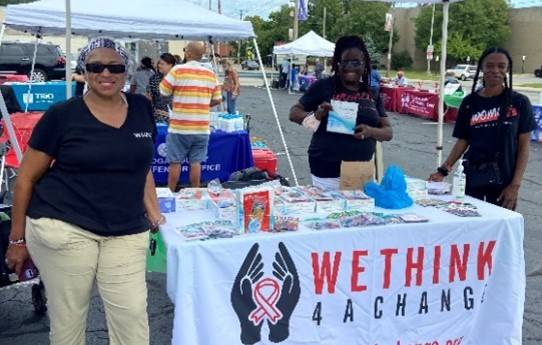You are here
World AIDS Day: Progress At Home and Overseas
Since 1988, each December 1st is recognized as World AIDS Day. The CDC Foundation is proud of our ongoing work in HIV research and prevention and is dedicated to continuing our efforts until HIV is eradicated worldwide. This year’s theme, Equalize, urges us to address the inequities that hold back progress towards ending HIV/AIDS.
According to the Centers for Disease Control and Prevention (CDC), one in eight people living with HIV in the United States is undiagnosed, and more than one third of all new HIV infections are transmitted by people who do not know they are infected. HIV self-tests are a confidential way for people to learn their HIV status. Because of COVID-19 lockdowns and closures, HIV self-testing increased over the past two years, and has proven a cost-effective way to make HIV testing more accessible, particularly in rural and traditionally underserved communities.
With the support of the CDC Foundation, 52 community-based organizations (CBOs) across the country are building upon their existing HIV work and establishing new, culturally relevant self-testing programs tailored to their communities. CBOs—such as faith-based organizations, community health clinics, advocacy organizations, AIDS service organizations and others—can help to expand self-testing in the communities that need it most. As trusted resources in their communities, CBOs help to close the gap on health disparities by sharing important health information across racial and ethnic groups in ways that overcome stigma, misinformation and fear about HIV. These CBOs are partnering with neighborhood businesses, schools, local and state health departments, and religious institutions to communicate the importance of knowing one’s HIV status and enlisting the help of respected local spokespersons in their outreach efforts.
While we continue to build on prevention efforts in communities around the United States, we are also supporting HIV research, intervention and prevention globally. Sub-Saharan Africa is the hardest hit region in the world; home to two-thirds of all people living with HIV globally. Strong laboratory and healthcare practices are at the core of any country’s ability to prevent, identify and respond to HIV, and this work begins with a well-trained healthcare workforce. In 2007, The U.S. President's Emergency Plan for AIDS Relief (PEPFAR), the Centers for Disease Control and Prevention (CDC) and the Kenya Ministry of Health (MOH) collaborated to create injection and blood safety programs to reduce medical transmission of HIV. The CDC Foundation built on that work by partnering with CDC and the global medical technology company BD to strengthen blood collection practices in Kenya. Under this partnership, CDC and BD hosted trainings on safe blood withdrawal practices for 500 healthcare workers from nine counties within Kenya.
The CDC Foundation also partnered with CDC, the Kenya Ministry of Health and the public health technology organization mHealth Kenya to expand Kenya’s Care for the Carer (C4C) system—a communication and training platform for healthcare workers. C4C’s mobile surveillance communication platform allows healthcare workers to report accidental exposure to HIV and receive detailed messaging on MOH guidelines and procedures following exposure. This also gives the government a way to track incidents of HIV exposure in medical facilities and better understand safety issues.
Elsewhere around the world, the CDC Foundation has partnered with CDC and donors to explore new methods of HIV prevention using pre-exposure prophylaxis (PrEP), the medicine that reduces your chances of getting HIV. These methods include combination contraceptive and HIV-prevention methods that allow for long-acting delivery of PrEP. In Thailand, where HIV/AIDS and sexually transmitted infections (STIs) are among the leading causes of death, we support HIV and STI prevention research, including the safety, efficacy and acceptability of injectable, long-acting HIV PrEP medicine for young men who have sex with men and transgender women.
These varied global and national approaches all rely on community partnerships to help tailor outreach to specific communities. As we renew our commitment to ending the HIV epidemic, we remain dedicated to working with CBOs to address inequities and disparities in accessing testing, treatment and care and exploring new methods to support communities disproportionally impacted by HIV. Together with these partners, we are exploring local, national and global approaches to eradicating HIV for good.
Enhancing Community Capacity to Support HIV Self Testing is supported by the Centers for Disease Control and Prevention of the U.S. Department of Health and Human Services (HHS) as part of a financial assistance award totaling $9 million with 100 percent funded by CDC/HHS. The contents are those of the author(s) and do not necessarily represent the official views of, nor an endorsement, by CDC/HHS, or the U.S. Government.
Portions of this publication were prepared under a Grant funded by Family Health International under Cooperative Agreement/Grant No. UM1 AI06819 funded by the National Institutes of Health. The content of this publication does not necessarily reflect the views, analysis, or policies of FHI 360 or the National Institutes of Health, nor does any mention of trade names, commercial products, or organizations imply endorsement by FHI 360 or the National Institutes of Health.

